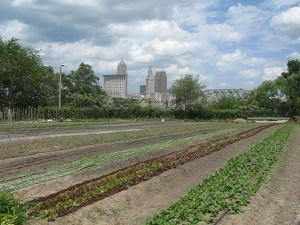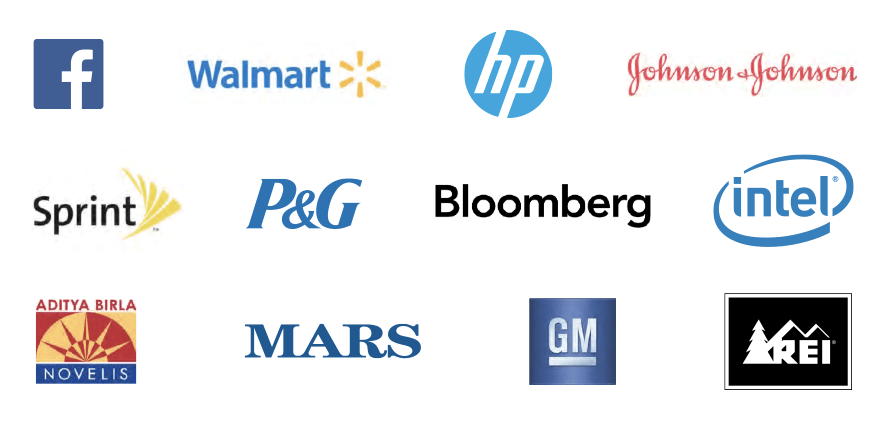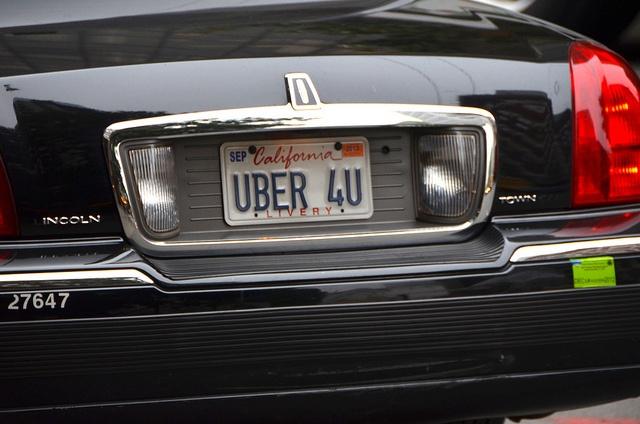A Look at Local Food and Urban Farming in Two American Cities


By Erica Morrell
Local food initiatives have taken off across the country in recent years. Registered farmers markets, for example, expanded nationally from around 3,000 in 2000 to over 8,000 in 2012, and urban farming has exploded across neighborhoods, at schools and in healthcare facilities -- with more than 1,200 community gardens across Detroit alone.
The rise in activities around local food presents a host of novel opportunities and challenges for municipal governments. Urban farming, for instance, may help address inadequate food access by expanding fresh produce options in the inner city, but at the same time it often occurs in violation of standing zoning ordinances and places new pressure on water and sanitation services.
In an attempt to promote its benefits and mitigate its drawbacks, cities across the country have created new arenas of governance concerned solely with local food. These arenas frequently include legislation around issues such as the production and sale of local produce and cottage foods, the creation of grants and other aid to facilitate local food efforts, and the establishment of food policy councils (over 200 such councils now exist across the U.S.), among many other features.
While different cities’ local food policies and programs might seem similar on the surface, they often embody quite different guiding values. Take Detroit and Cleveland, for example. Based on citizen demands, Detroit’s government has committed particularly to promoting justice through activities around local food.
The city’s Food Security Policy affirms this in its call to “identify and eliminate barriers to African-American participation and ownership in all aspects of the food system,” “increase the number of culturally appropriate food outlets,” and “ensure that the food needs of young families and the elderly are met,” as does its Food Policy Council vow to conduct business “in ways that embodies a commitment to anti-racist, anti-sexist, and anti-elitist processes and outcomes.”
Meanwhile Cleveland’s officials have pledged to advance development (especially economic and sustainable) through their local food policies and programs. The city’s Urban Agriculture Overlay District zoning provision was adopted as a means to “promote urban agriculture while simultaneously creating economic development opportunities” as was its Ordinance No 210-11 endorsed to foster “economic opportunities that create living-wage jobs, a unique Cleveland, and economic sustainability within the city” by facilitating local mobile food entrepreneurs. In 2012, Cleveland celebrated the Year of Local Foods to “advance sustainability … while boosting the local economy.”
Undoubtedly the values driving local food governance have direct implications for private business. The city of Cleveland’s commitment to the goal of economic development via local food, for example, has propelled legislation that guarantees a bid preference for companies which source products grown locally.
But perhaps more significantly, the principles undergirding municipal approaches to local food governance often reveal as well as reinforce the overall climate of a city’s local food system, creating broader potential opportunities and constraints for entrepreneurs in the food system.
Consider Whole Foods Market's experiences in Detroit and Cleveland, for instance. The company explicitly values and pursues “customer satisfaction, team member happiness and excellence, return on capital investment, improvement in the state of the environment and local and larger community support” but neither explicitly justice nor development.
Nonetheless,when seeking to open a Detroit store, Whole Foods Market met with pushback not from any single policy but simply from the established justice values characterizing the local food system there. Consequently, Walter Rob, the company’s co-CEO, reached out to local food justice leaders to figure out how the store might play into “race and gentrification and power in Midtown.” The company then engaged in unprecedented measures to address these issues head-on, including holding community meetings and creating an advisory group of non-profit, government, and community organizations which were “faithful” to “a vision of justice” when engaging the corporation ahead of the store’s Detroit opening.
Contrastingly, in Cleveland where development is a stronger driving value, residents did not resist a Whole Foods Market opening in their community but rather called for the store to come to their neighborhood. It was not policy but
a grassroots social media campaign with over 3,000 members that called for the store to come and “create a huge economic-development opportunity” for the area. According to its regional president, as the company considered opening a new location on Cleveland’s West side it thus, unlike in Detroit, had to focus particularly on “encouraging economic growth”—not justice—in creating a store best designed to meet community demands.
Paying attention to the values driving local food governance thus sheds light on the explicit legislation as well as the overall socio-political climate that may impact if and how local food initiatives—including private business—variously develop between cities.
All images by Erica Morrell
Erica Morrell is a PhD candidate in public policy and sociology at the University of Michigan. In research and teaching, she works at the intersection of policy studies, science and technology studies, social movements and the environment with an eye toward political contention and democratic engagement vis-a-vis food systems. Currently she is completing her dissertation on the comparative politics of local food.
Eileen Fisher Leverages Employee Values to Chart Path Toward Long-Term Sustainability


In fashion designer Eileen Fisher’s world, 1,000 people are capable of making a difference. And when she says people, she means her employees — a team committed to social consciousness that has served as a sounding board for many of the leading brand’s sustainability initiatives in recent years.
Armed with a commitment to gather consensus from employees and inspire leadership practices, Eileen Fisher has curated a culture that allows employees to be leaders of change both internally and within the brand's work in society at large.
Hiring policies hold significant weight as the brand continues to pursue activities that incorporate stronger sustainability practices and charitable partnership programming. In 2012 upon receiving an Apparel Sustainability All-Star Award, Shona Quinn, Eileen Fisher’s sustainability leader, mentioned that the company has an effective sustainability program as a result of employees with strong social values who are predisposed to consider the environment.
The range of employee contributions to the company’s sustainability strategy is voluminous. Prime example: An employee request to eliminate the use of plastic resulted in an 80 percent reduction of plastic hangers used in stores.
The casual-wear brand has led the charge toward transparency and sustainability in the fashion industry for years. The company has used natural fibers and eco-friendly fabrics for over a decade, and the materials are a hit with its 33- to 50-year-old female target consumers. Bucking sweatshop labor practices and other common fashion industry snafus, Fisher's legacy is rooted in her commitment to ethical and responsible business practices that treat employees as owners and the planet as a shareholder.
At one point Fisher contemplated taking the company public, but she ultimately decided to keep things simple and focus on getting the product right while offering an employee stock program that breeds inclusivity.
"My employees run the business, and they deserve to own it. We've done profit sharing for years, and it makes people feel really connected," she shared with Inc. in 2010. "It's not us and them. It's us."
Fisher’s commitment to sustainability spans a portfolio of enviable initiatives. For example, the Green Eileen brand launched in 2009 allows customers to return their outgrown and gently-worn Eileen Fisher clothing to the store for credit and an opportunity to support programs that empower women and girls. Green Eileen recycling stores in New York and Seattle have collectively re-sold more than 160,000 garments to date, raising up to $2.2 million and diverting textiles from landfills.
In 2009, Eileen Fisher became the first American member of the Blue Sign Technologies network, which is working closely with the company to establish a sustainable textile production system to using less dye, chemicals and water to produce their China silks. By 2015, the Eileen Fisher brand plans to produce 50 percent of its products using Blue Sign's eco-solution system. The company ultimately plans to make 100 percent of its clothing sustainable by 2020.
Upon celebrating 30 years in business, and over $360 million in revenue in 2013, Fisher has no plans to slow down but instead has her sights set on sketching out goals, with the help of her employees, for the next 30 years.
“These days I'm focused on the concept of good growth. I constantly ask myself and my employees, "How do we grow in ways that are sustainable, and ways we can be proud of?" -- Fisher writes on Inc.
Image credit: Eileen Fisher Facebook
Sherrell Dorsey is social impact branding and communications strategist, social entrepreneur and advocate for environmental, social and economic equity in underserved communities. Visit Sherrell at www.sherrelldosey.com and follow her on Twitter and Instagram @sherrell_dorsey.
U.K. Grocer Becomes the First Retailer to Issue a Sustainable Seafood Report


The British supermarket chain Asda is the first retailer to publish a sustainable seafood report.
The report, titled Wild Fisheries Annual Review, lists all of the fisheries used by the supermarket chain between Jan. 1 and Dec. 1, 2013. The report contains management and sustainability information for all of the fisheries that supply the supermarket chain with wild fish. Seafood from aquaculture (fish farming) is not listed, but Asda hopes to include this information in next year’s report. (As the name implies, it will be published every year.)
The report names each fishery, and information is provided on the location and catch methods, plus sustainability assessments that include environmental impacts.
The report is part of Asda’s commitment to ensure its wild seafood is responsibly sourced. That said, the company knows that some fisheries it obtains seafood from need work and is working to address the issues. One example is Asda’s pledge that all ambient canned and pouched tuna will be line-caught or caught using fish aggregation device (FAD)-free methods by the end of 2014.
Asda worked with Sustainable Fisheries Partnership (SFP), a U.S. nonprofit, to publish the report. SFP keeps a database of all the wild seafood bought by Asda, which includes information on the stocks where the fish are caught. The database also includes the name, species, gear type (how the fish is caught) and nationality of fishing boats. There is a weblink for each entry that connects it to a detailed profile on a public database called FishSource which provides more information. Any fishery improvement projects in place are included.
An assessment is given of whether the fishery is well managed and a score is given based on five elements -- each scored from one to 10. A low score is negative and a high score is positive. The following three categories are used to assess performance:
- Category A: A stock where all scores are over eight is in 'great' shape
- Category B: A stock where all scores are over six is in 'good' shape
- Category C: A stock that has any score below six needs to significantly improve
The findings
About 24 of the 64 fisheries used by Asda are certified as sustainable by the Marine Stewardship Council. Four fisheries are under review and 10 are under general improvement. Thirteen fisheries scored an ‘A,’ 19 scored a ‘B’ and 18 scored a ‘C.’ Five were not scored.
Both Greenpeace and Hugh Fearnley-Whittingstall, the British celebrity chef, have campaigned for supermarkets to become more transparent on seafood sourcing, and both praised Asda for releasing their report.
“Greenpeace applauds Asda for this bold display of honesty and transparency about the seafood they sell,” said Sarah North, head of the Oceans Campaign at Greenpeace U.K. North added that Asda’s British customers are now “armed with the information they need to choose more sustainable fish, and can follow Asda's journey as it continues to work hard to improve its seafood sourcing.”
“I applaud this step by Asda to be transparent about all the wild seafood that has their name on it. It shows a mixed picture: over a third of the fisheries are certified sustainable, but several of them - like those for dredged scallops and rays - remain a real cause for concern,environmentally,” Fearnley-Whittingstall added.
For more information on the sustainable seafood movement, check out this ongoing series on Triple Pundit.
Image credit: Asda
Alternative Building Method: Aerated Concrete


When I think of concrete buildings, I think of dense, heavy concrete with a high environmental impact: Cement manufacturing accounts for 5 percent of global CO2 emissions from human activity, a staggering total for one building material. But utilizing more environmentally-friendly alternatives, such as autoclaved aerated concrete (AAC) blocks, does offer many benefits.
Chemical reactions with gases make autoclaved aerated concrete a lighter, more insulated and fire-resistant alternative to concrete. AAC blocks and panels can also be molded and cut into dimensional units. Generally, they're more popular in post-war Europe than in the U.S. -- and they have been widely used in the U.K. and Germany.
Lightweight
AAC blocks are 80 percent air and 50 percent lighter than clay blocks of the same size, meaning they require less energy than concrete to transport. Compared to concrete AAC is also easier to cut and shape, boosting design flexibility and reducing waste with more accurate cutting.
Durable
AAC blocks are insect- and rot-resistant, and they are not destroyed by floods, according to the Portland Cement Association. These attributes are especially appealing in humid climates, and the use of AAC blocks can help reduce or eliminate the use of drywall or wood, preventing mold issues. The blocks are also sound resistant, and because they are non-combustible, they do not give off toxic fumes in a fire.
Energy efficiency
The R-value is similar to a typical stick frame house, but the blocks have a greater thermal mass -- making the home more resistant to changing temperatures. This seems like a slight improvement over many code-built homes on the market, but AAC blocks alone don't make a house ultra energy efficient.
Drawbacks to AAC
Because AAC contains concrete, it does have some of the same environmental drawbacks of concrete -- but to a lesser extent because less cement is used to make the product. AAC is more expensive than concrete blocks, thus some builders mix use of both tradition cement and AAC.
Fly ash in concrete raises concern
As much as 30 percent of the concrete can be replaced by fly ash, a hazardous coal combustion byproduct from coal power plants. This practice is praised by many industry groups and criticized by some environmentalists, who call it the new asbestos. It does raise safe handling and health concerns from production to end-of-life disposal.
There is currently a proposed rule by the EPA to would regulate coal ash use. This could have an impact on the cement industry, as fly ash is contained in many products. “It’s very complicated,” says Scot Horst, senior vice president in charge of the green-building rating system Leadership in Energy and Environmental Design (LEED). “If fly ash is a hazardous waste and it becomes part of a concrete wall, is the wall a hazardous material?”
Overall, AAC does have some appealing qualities when compared to typical cement. Locally-produced AAC blocks are available in many areas, but the benefits are most pronounced in certain climates, where certain attributes are especially appealing. In colder climates, the AAC blocks alone won't perform as well.
Ultimately, like with many others, how green and useful this alternative building product is depends on the use and goals of a particular project.
Image credit: Flickr/funadium
G20 urged to push equal pay agenda


Women won't be paid as much as men for another 75 years according to a report released by Oxfam International, which urges G20 leaders to tackle gender inequality when they meet in Australia later this year.
The G20 and gender equality – How the G20 can advance women's rights in employment, social protection and fiscal policies report shows how the G20's growth ambitions cannot be realised without policies addressing systemic discrimination and economic exclusion of women across G20 countries.
The report, co-published with the Heinrich Boll Foundation, is being released as the Business 20 (B20) – one of the satellite conferences in the lead-up to the G20 Leaders Summit in Brisbane in November - meets in Sydney this week.
Oxfam International executive director Winnie Byanyima said that across G20 countries and beyond, women were paid less than men, did most of the unpaid labour, were over-represented in part-time work and were discriminated against in the household, markets and institutions.
“This gap between women and men reflects a fundamental and entrenched form of inequality afflicting G20 countries, despite the gains that have undoubtedly been made in some areas,” Byanyima said.
Depending on the country context, an extra 20%-60% would be added to the GDP of individual G20 countries if the hidden contribution of unpaid work – such as caring for children or carrying out housework – was recognised and valued.
Byanyima commented: “Meanwhile, if women's paid employment rates were the same as men's, the USA's GDP would increase by 9%, the Eurozone's by 13% and Japan's by 16%.”
PETA calls for end to wool trade


Animal rights pressure group PETA (People for the Ethical Treatment of Animals) is asking retailers and consumers to say ‘no’ to products containing wool, citing the abuse of sheep during shearing, live export and mulesing (flaying of live lambs) as three reasons to avoid wool.
A recent exposé by the US arm of the organisation on the wool industry in the US and Australia – the source of 90% of merino wool in the world – shows severe mistreatment and abuse of sheep in farms and shearing sheds.
"Sheep are gentle prey animals who are petrified of even being held down, yet these sheep were punched in the face, kicked and stamped on and had their heads slammed into the floor by unsupervised, impatient shearers, causing them great distress, injury and even death,” says PETA UK Associate Director Mimi Bekhechi. "PETA is calling on shoppers around the world to reject cruelty to animals – and that means never buying wool."
PETA has sent copies of the exposé video to UK retailers that sell wool. In the US, it has asked state and local law-enforcement agencies to investigate and file criminal charges against the workers, as appropriate, for what are believed to be violations of cruelty-to-animals laws.
Fortune 500 Companies, NGOs Unite to Address Renewable Energy Demand


The growth in wind and solar energy over the past several years has been impressive, but the pace of change has been achingly slow for companies that want more renewable energy than the market can provide. With that in mind, 12 leading U.S. companies have partnered with the World Wildlife Fund (WWF) and the World Resources Institute to make one thing perfectly clear: There is a huge, unmet renewable energy demand by businesses, and a change in energy markets will be required in order to meet that need.
The linchpin of the collaboration is a set of strategic guidelines called the Renewable Energy Buyers’ Principles. Most of the 12 companies that have signed on are familiar names at Triple Pundit for their proactive approach to renewable energy or other sustainability issues, including Bloomberg, Facebook, General Motors, Hewlett-Packard, Intel, Johnson & Johnson, Mars, Novelis, Procter and Gamble, REI, Sprint and Walmart.
8.4 million megawatt-hours of renewable energy demand
According to WWF, the 12 companies signing on to the Renewable Energy Buyers' Principles have calculated that their renewable energy demand adds up to 8.4 million megawatt-hours per year through 2020.
That's just those 12 major companies, so 8.4 million is just for starters. These companies represent a noticeable level of interest in renewable energy among major business sectors in the U.S., including IT, media, retail (Ikea also comes to mind, though it is not headquartered in the U.S.) and manufacturing.
When you consider other sectors of the U.S. economy that are proactively adopting renewable energy, including professional sports, government agencies, and nonprofit stakeholders like religious organizations and academic institutions, you can see that the unmet renewable energy demand in the U.S. is astronomical.
As for why utilities have been acting so slowly, some have been acting much more quickly than others, but overall the problem is that the traditional, centralized model of power supply does not easily embrace the local, distributed sourcing that is a key attraction of renewable energy.
The Renewable Energy Buyers' Principles
The Buyers' Principles are focused on shifting the market as applied narrowly to the traditional centralized power plant model. They are not meant to address political and legislative obstacles that have burdened renewable energy development in the U.S.
However, those obstacles are not set in stone, and once they start falling there will still be a need for a clear path toward a market that accommodates both renewable energy and advanced energy storage opportunities.
With that in mind, the Buyers' Principles (here's that link again) lays out six areas in need of change:
- Greater choice in procurement options. This principle is clearly aimed at enabling businesses to reach outside of their local utility for energy suppliers.
- More access to cost competitive options. This part of the strategy embraces the potential for renewable energy to compete on price with other fuels on a long-term basis, whether supplied by utilities or other parties.
- Longer- and variable-term contracts. Aside from its potential for costing the same or less than conventional energy, locally-sourced renewable energy provides a critical, long-term buffer against the price spikes that bedevil conventional energy markets.
- Access to new projects that reduce emissions beyond business as usual. As companies build a sustainable identity, they want to be able to claim sole ownership of the renewable energy projects they support. This involves local sourcing wherever possible, and eliminating the "double-counting" renewable credits.
- Streamlined third-party financing. Of particular interest to smaller companies is this item, which would make it easier for companies to access power purchase agreements and other third-party arrangements.
- Increased purchasing options with utilities. Recognizing that some utilities have the flexibility, opportunity and will to embrace distributed energy generation, this item admits the potential for companies to get more and cheaper renewable energy within the existing utility and regulatory framework.
Collaboration = Accelleration
The aim of the Buyers' Principles is to rally major energy consumers around a strategy that will pick up the pace of renewable energy generation in the U.S.
It's a good example of the collaborative, shared-platform model for sustainability progress that has been emerging as a global force. A large portion of the focus is on streamlining renewable energy procurement, which obviously benefits the big players, but it will also enable smaller consumers to jump into the market without having to reinvent the wheel.
Amy Hargroves of Sprint sums it up this way:
Very few companies have the knowledge and resources to purchase renewable energy given today’s very limited and complex options. Our hope is that by identifying the commonalities among large buyers, the principles will catalyze market changes that will help make renewables more affordable and accessible for all companies.
For a parallel example you can look at the U.S. Army, which has emerged as a standout example of trail-blazing new strategies to meet its renewable energy demand.
The Department of Defense initially began installing large-scale solar power plants on an individual, ad hoc basis at its facilities. The pace picked up considerably after 2012, when the Army established the Energy Initiatives Task Force to cover all of its opportunities for building utility-scale solar power plants, and combined it with the streamlined procurement process of the Army Corps of Engineers.
The over-arching goal, aside from greenhouse gas management, is to reduce DoD's dependence on grid-supplied energy.
Image courtesy of the World Wildlife Fund
Is Uber Exploitative? And What Does It Say About the Sharing Economy?


Sometimes it looks like Uber has become the world’s favorite punching bag, from taxi drivers across Europe complaining that Uber is “not playing by the rules” to American customers annoyed with the company’s surge pricing tactics.
One of the latest punches came from Andrew Leonard, a staff writer at Salon, who compared Uber to John D. Rockefeller.
Why? Leonard didn’t like the fact that Uber significantly reduced the prices of UberX rides in New York and other cities, making them cheaper now than taxi rides. He suggested that Uber’s deep pockets (it just raised $1.2 billion) could enable the company to lose money on every ride, claiming this is an “anti-competitive market behavior.”
And the connection to Rockefeller? “The founder of Standard Oil built his monopoly by exploiting size to leverage discounted access to railroad transport. Such economies supported price cuts his competitors couldn’t match,” Leonard writes. He’s afraid that we’re about to witness a somewhat similar scenario in the taxi industry, where Uber will use its funds to drive taxis out of business, and then will increase prices, making its investors rich at the expense of the public.
Leonard, as well as others sharing similar concerns, questions the legitimacy or fairness of Uber’s business tactics, especially given the fact that it operates in many places within a "grey area" of the law. Yet, behind these arguments lie even more fundamental questions: Is Uber still considered part of the sharing economy? Is it exploitative? And if you answer ‘yes’ to both questions, what does it say about the sharing economy?
Let’s try to look at these questions one by one.
To answer the first question, we might need to look at what the 'sharing economy' actually means. Rachel Botsman, co-author of “What’s Mine Is Yours: How Collaborative Consumption is Changing the Way We Live,” divides the ‘sharing space’ into four parts: collaborative economy, collaborative consumption, sharing economy and peer economy. In her analysis, she includes UberX as an example of the fourth part -- peer economy, which she defines as: “Person-to-person marketplaces that facilitate the sharing and direct trade of assets built on peer trust.”
In a report published last year, “The Sharing Economy: Accessibility Based Business Models for Peer-to-Peer Markets” the authors write: “Due to the lack of scientific publications on 'the sharing economy' we confine its definition to companies that deploy accessibility based business models for peer-to-peer markets and its user communities. This type of business model … can, in theory, act as a broker between consumers, for any consumer owned product or service.”
Finally, Cameron Tonkinwise, the director of design studies at the School of Design at Carnegie Mellon University, approaches the definition in his paper “Sharing you can believe in” from a sustainability point of view: “If a system affords people a way of not having to own things in under-utilized ways in individual households, I am going to call it sharing … If a ‘sharing economy’ service creates a new practice that does not replace another practice that depends on owned goods, then it does not meet this aspect of my definition,” he writes.
So, as you can see, the answer to the first question is: Sometimes. UberX can definitely be considered an example of a peer-to-peer market (unlike Uber Black or Uber SUV, it’s not operated by commercially licensed taxi and black car drivers), and if it’s been used as an alternative to buying a second car, for example, it can even be considered sustainable. In all other cases, Uber is neither a sharing nor a sustainable service.
The answer to the second question about the exploitative nature of Uber is not simple either. One way to look at Uber, Glenn Fleishman suggested last month on BoingBoing, is as “an upstart technology company [that] optimizes an inefficient market in a way that all participants benefit: passengers are safer and can more reliably get a ride with a low likelihood of fare cheating; drivers are safer and don't have people skip on fares.” At the same time, Fleishman warns it can all change if Uber reaches a dominant position in the industry, as the company could become then “both a virtual monopoly and a monopsony.”
Others are more blunt. Economist Michael Munger of Duke University compared Uber’s model to buying cartons of cigarettes cheaply in Virginia and selling them from the back of your truck in New York, where the price of cigarettes in stores is far more expensive. Consumers will love it, Munger says, but this creates an unfair competition for those trying to follow the rules.
Yet, both Fleishman and Munger agree that Uber and other car-sharing services challenge an industry that is inefficient, relatively expensive and has very little incentive to improve due to regulation providing it with an artificial monopoly power. In other words, it might be that not just Uber, but also the incumbents in the taxi industry that fiercely fight it could be perceived as exploitative to some degree.
However, I wouldn’t like to run away from the question. In my opinion, the fact that Uber finds ways to get around the law as Munger puts it, or reduces prices, utilizing a loss leader pricing strategy, could be characterized in different ways (illegal, unfair competition, a threat to property rights, a bully, etc.) -- but not as exploitative. At least for now.
What will happen in the future? Will Uber one day transform into a ruthless monopoly taking advantage of its drivers and charging unreasonable prices for rides? Maybe, but I doubt that this will be the case. Not that I count too much on Uber’s morality or the regulators as much as I count on the power of the market. If Uber fails to fulfill its promise to provide a better service, it can go down as fast as it went up.
So, finally, what does it all say about the sharing economy? One way to look at it is that the story of Uber reminds us that we’re going through a process of mainstreaming the sharing economy. This, as Clay Shirky suggests, includes five stages that the sharing economy will have to go through: technical possibility, social adoption, regulatory reaction, civil disobedience and negotiated settlement.
Another way to look at it is that we’re seeing a movement in transition. Rachel Botsman describes it as something that is still a child, and when asked how she sees it when it’s grown up, she jokingly replied “pimply.” Well, it might be that Uber is just a sign of the sharing economy’s a pimply adolescence, for better or worse.
Image credit: Adam Fagen, Flickr Creative Commons
Raz Godelnik is an Assistant Professor of Strategic Design and Management at Parsons The New School of Design. You can follow Raz on Twitter.
How Cities and Businesses Are Working Together to Address Climate Change


This is a little ironic; no, it’s more than a little ironic. Congress won’t act on climate change for fear of adversely impacting businesses. So, cities and states are picking up the slack, taking aggressive action, in order to protect their… wait for it…businesses.
A new report entitled Protecting Our Capital, released by the CDP, claims most cities recognize that climate change poses a considerable risk to their local businesses and therefore their economy and well-being. Of course, it’s only a small fraction of businesses that are actively lobbying against climate action -- mostly those in the fossil fuel industries who have the most to lose. Most of them now acknowledge the problem and, even as they hope to slow government action, are moving to address the challenges.
The report, which is based on responses from 207 cities, documents the recognition of the interdependence between cities and businesses. Of those surveyed, 76 percent of cities said that climate change could impact business, while businesses said that 75 percent of their biggest climate-related risks could also be seen as threats to their respective cities.
What kinds of risks are they talking about? These could include rising insurance costs, loss of tourism, supply chain issues and a lack of raw materials. Drivers of these costs will stem from storms and flooding, sea level rise, temperature increases, drought, and other weather-related disruptions and destructions.
A total of 757 carbon reduction drivers were reported.
Notably, the cities of Denver (U.S.), London (U.K.), Madrid (Spain), Durban (South Africa) and Taipei (Taiwan) combined to reduce their emissions by a total of 13.1 million tons CO2-equivalent since 2009. That’s a 12 percent reduction.
Joint efforts between businesses and cities include:
- Fire risk management and water monitoring (Sempra Energy/San Diego)
- Water management and flood preparedness (Sabasep/Careiras Brazil)
- Flood defense and infrastructure resilience (CLP/Hong Kong)
- Reduced energy demand and heat island effect (Caixa Geral de Depósitos/Lisbon)
In a similar vein, Recyclebank just announced a top 10 list of the most inspiring U.S. sustainability programs, most of which also involve cities and business working together. Among these are:
- Green buildings in Chicago. This features the city working in conjunction with the Chicago Center for Green Technology. The city currently has 295 LEED certified projects.
- Wind energy in Corpus Christi, Texas. The city has partnered with the Port of Corpus Christi and Texas A&M University to establish America’s Wind Power Port.
- Xeriscaping in Denver. The city has partnered with Denver Water to make plans and design information for this water-conserving type of landscaping available to every resident.
- Organic food in La Farge, Wis. Organic farming co-op Organic Valley has used state, village, federal and private funding to turn the area in a sustainable dream town. There is the Kickapoo County Fair hosting sustainability workshops and more organic farms than any other area in the country.
- Solar in Long Beach, Calif. Both the convention center and the airport are examples of how the local government has made it easy for businesses and individuals to install solar PV systems, going so far as to provide a manual to help residents to apply for government tax credits.
- Landfill Rehabilitation in New York. The former site of the world’s largest landfill, is being converted into a park with remediation measures that will exceed all public health and safety regulations. At 2200 acres, Freshkills park, which will be situated on the west shore of Staten Island, will be almost three times the size of Central Park.
- Climate Positive Community in Oberlin, Ohio. The city and the college are working together to achieve a goal of reducing emissions by 50 percent by 2015, and utilizing local food to meet 70 percent of demand.
- Sustainable engagement in Philadelphia. The cities Greenworks initiative has set sustainability goals for energy, equity, environment, economy and engagement. They have taken actions including enhanced recycling, increased use of renewables, home weatherization and tree planting.
Portland, Ore. and Wilmington, Del. were also called out for their efforts in sustainable transportation and recycling of organic wastes.
Because of the interdependent nature of our climate vulnerabilities, alliances between disparate sectors can, as these efforts show, make a significant dent in the problem.
Image credit: Seth Oliver Photographic Arts: Flickr Creative Commons
RP Siegel, PE, is an author, inventor and consultant. He has written for numerous publications ranging from Huffington Post to Mechanical Engineering. He and Roger Saillant co-wrote the eco-thriller Vapor Trails. RP sees it as his mission to help articulate and clarify the problems and challenges confronting our planet at this time, as well as the steadily emerging list of proposed solutions. His uniquely combined engineering and humanities background help to bring both global perspective and analytical detail to bear on the questions at hand.
Follow RP Siegel on Twitter.
Apple’s Environmental Report Reveals Major Accomplishments, More Work To Be Done


Apple’s carbon footprint shrank 3 percent from 2012 to 2013. It's a modest decline, but this is the first time the tech giant has seen a year-over-year decrease in greenhouse gas emissions since it started tracking them in 2009.
Despite this and other accomplishments detailed in Apple's 2014 Environmental Responsibility Report released this week, the company acknowledged it has a long way to go to reduce its environmental impact, including tackling emissions from its manufacturing partners and addressing its recent increase in water consumption.
The greenhouse gas emissions from Apple’s energy consumption fell by almost a third over the last three years, the report found, even though the tech giant’s overall energy use jumped 42 percent during the same time. These avoided emissions are equivalent to taking 75,100 cars off the road or powering 49,100 homes for one year, according to the report.
The Cupertino, Calif.-based company said its investments in clean energy were responsible for the impressive drop in its energy-related carbon footprint: All of Apple’s data centers – which run services like Siri, the iTunes and App stores, and Maps – run on 100-percent renewable energy sources, including solar, wind and geothermal power.
“So every time a song is downloaded from iTunes, an app is installed from the Mac App Store or a book is downloaded from iBooks, the energy Apple uses is provided by nature,” the reports authors wrote.
As of this year, Apple powers 145 of its U.S. retail stores and all of its Australian stores with 100-percent renewable energy, according to the report. Five of its corporate campuses, including its Cupertino, Calif. headquarters, also run on 100-percent renewable energy. Apple is currently building a new Cupertino campus and said the new facility will also operate on 100-percent clean energy and be ultra-energy efficient, using natural ventilation for 75 percent of the year.
In addition to cleaning up its energy consumption, the maker of the iPhone is reducing greenhouse gas emissions from its employees’ commutes. Its commute alternatives program – which includes transit subsidies, biodiesel buses that shuttle employees to and from work, and carpooling incentives – provided more than 1 million trips last year and cut carbon emissions equivalent to taking more than 15,000 cars off the road for one year.
The company is also addressing what happens to its products at the end of their useful life, reporting that every Apple retail store in the world now takes back its devices for free and recycles them responsibly. Since 2010, Apple has collected 85 percent of the total weight of the products it sold seven years earlier, the report said.
But Apple’s Environmental Responsibility Report also called out challenges the company needs to work on. Apple’s water consumption climbed from 20 cubic meters per employee in 2012 to 29 cubic meters in 2013, the report said, due to construction of the new Cupertino campus, the addition of new server rooms and testing equipment in existing facilities, and general company expansion worldwide. The tech giant said it has established a clean water program to tackle its high water use and keep its suppliers on board with its conservation efforts.
Another obstacle the report noted is the carbon emissions from Apple’s manufacturing partners – which make up the largest portion of the company’s overall carbon footprint. While Apple said in a blog post that it is “committed to addressing” these emissions, the report is noticeably silent on ways the company will clean up operations at the notoriously-polluting Chinese factories it contracts with.
On this year’s Earth Day, Apple announced it would provide consumers with more frequent updates on the company’s progress towards greater sustainability. The new Environmental Responsibility Report fulfills that promise and demonstrates how far the tech icon has come in its environmental initiatives and corporate transparency in recent years. Previously lambasted by environmental groups like Greenpeace for lagging behind other companies in sustainability and failing to disclose the environmental impact of its operations, Apple has proven it is making strides in the right direction – though there is still more work to be done.
“Apple is still far from perfect – it has issues that it must address throughout its supply chains for materials, energy and labor, including in China,” Kumi Naidoo, Greenpeace International’s executive director, wrote in a blog post in April, “but by being so open about its sustainability goals, Apple is indicating a willingness to be held accountable for its impact.”
Image credit: Apple
Passionate about both writing and sustainability, Alexis Petru is freelance journalist based in the San Francisco Bay Area whose work has appeared on Earth911, Huffington Post and Patch.com. Prior to working as a writer, she coordinated environmental programs for Bay Area cities and counties. Connect with Alexis on Twitter at @alexispetru